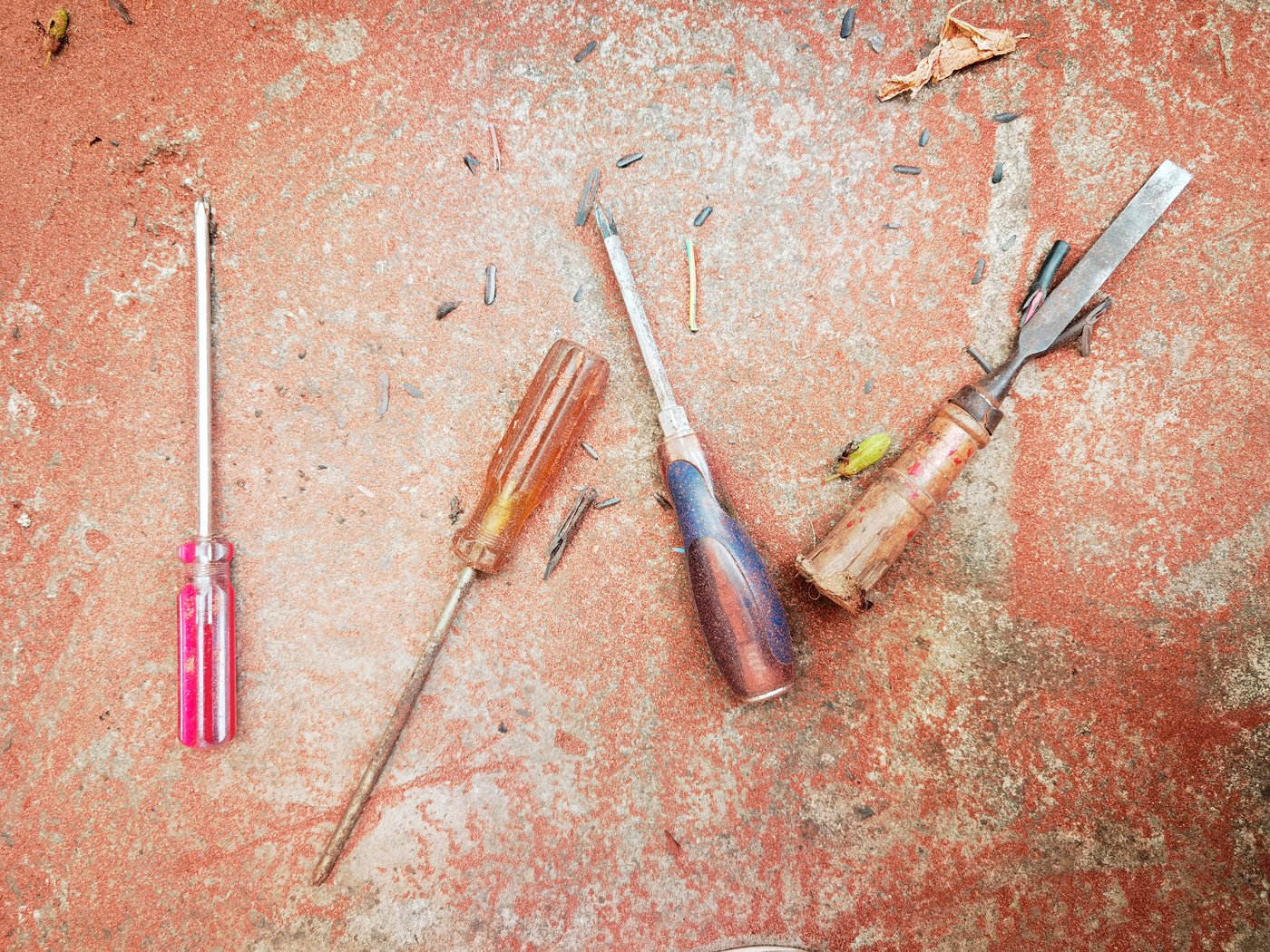10 TIPS FOR BETTER MOBILE PHOTOGRAPHY
© Achintha Dahanayake | Huawei Nova 2i | Snapseed
Nowadays, almost everyone has a very powerful camera in their pockets, the smartphone you carry everywhere you go. You may have a specific brand you prefer over the others. Still, almost all modern smartphones come with an extremely capable digital camera. If you use it right, you can become a good photographer. You just have to follow some basic rules. These aren't actually rules; these are sets of guidelines you can follow to level up the quality of your photos. And these steps aren't even hard to follow or remember. Let me give you a few tips to follow.
1. USE THE RULE OF THIRD
You might have heard this before. This rule is the most commonly used rule for composing eye-pleasing photographs. Basically what it means you have to place your subject off the center of the frame. Let me explain. First, you have to divide your frame into thirds, vertically and horizontally (two vertical lines and two horizontal lines), so you will have nine squares. Then place your subject on one of the four intersection points as shown in the below examples.
© Achintha Dahanayake | Huawei P40 Pro
Now it's even easier to compose using the rule of thirds because almost every smartphone camera app comes with a feature called "Grid Lines." You can easily turn it on in the camera app settings. If it's not turned on by default you can easily turn it on in the settings. (In my camera settings, it is mentioned as "Assistive grid" (above example), once turned on, you will have the rule of the third guide next time you shoot. When you are following this rule, it shouldn't have to be precise. Just don't place your subject right in the middle of the frame. Place it in the off-center. (You can break this rule and put the subject in the dead center of the frame and still capture a beautiful photograph. But learn the rule first, and then you can break the rule like a pro)
2. KEEP THE HORIZON LINE STRAIGHT
© Achintha Dahanayake | Huawei Nova 2i | Snapseed
This tilted horizon is one of the most commonly ignored mistakes I've seen among amateur photographers. Unless you have a reason supporting your story, always keep your horizon straight and leveled. Crooked horizons and badly aligned lines create undesirable results. Tilting the horizon intentionally to create an interesting composition is OK, but not paying attention to the tilted horizon line is bad practice. So next time you point your camera toward something, pay attention to the horizon line and ensure it's straight. To make this easier, use the built-in level indicator in your camera app.
3. TRY TO KEEP THE FRAME SIMPLE AND MINIMAL
© Achintha Dahanayake | Huawei Nova 2i | Snapseed
There is a saying, "Less is more." Next time, Instead of including as much as possible in the frame, try to include as little as possible. We see hundreds of thousands of photographs on social media platforms. They are filled with texts, ads, colors, and many other distracting things. A minimally composed photograph is like a breath of fresh air in that cluttered mess. Also, when we browse through social media and see a very minimally composed photograph, It kind of forces us to stop and look. It helps to take the viewer's attention.
4. EXPERIMENT WITH DIFFERENT CAMERA POSITIONS
© Achintha Dahanayake | Huawei Nova 2i | Snapseed
Another common mistake amateur photographers make when composing a photo is, composing at eye level, every time. If you want to be a good photographer, you have to break this habit and experiment with different camera positions. When composing at eye level, you end up with a boring-looking photograph that feels like you have seen it before. It doesn't have that wow factor you want. It’s because we mostly experience the world through our eyes. At our eye levels. Try changing your camera position. Instead of standing and taking the shot, try lowering the camera position or higher. Try to shoot from an unusual angle that people are not experiencing or seeing every day.
5. USE LAYERS WITHIN THE FRAME
© Achintha Dahanayake | Huawei P40 Pro | Snapseed
We see the world in 3d, but the photographs are in 2D (two-dimensional). Showing a 3d subject on a 2d platform is tricky, but it creates an interesting result when done right. To create a sense of depth in a 2d platform, you must create a clear separation between the foreground, midground, and background and place your subject accordingly. This method can’t be applied to all situations. It depends on the situation and subject you are capturing. But figuring out the layers within the scene you are capturing is a good compositional habit. This practice will help you to become a better photographer and stand out from the rest.
6. DON'T OVER-PROCESS / EDIT YOUR PHOTOS
© Achintha Dahanayake | Huawei P40 Pro | Unedited
Different smartphones have different algorithms to process their images. As soon as you press the shutter button, those algorithms kick in and start processing your photo. (this process happens within milliseconds, thanks to modern processors and software) so you already end up with a heavily processed photograph with various filters applied. So you must be very careful when editing your photos using different filters. Daily I see pictures with pumped-up saturation and contrast to the extreme. You have to be mindful when editing your photos. As for me, I normally dial down the saturation.
7. SLOW DOWN, AND PAY ATTENTION TO THE LINES, PATTERNS, AND TEXTURES AROUND YOU
© Achintha Dahanayake | Huawei P40 Pro | Unedited
There are so many interesting subjects around us that we normally miss or ignore. We often miss those because they are not so very obvious subject matters we like to photograph. But if we slow down and look closely, we will find these interesting lines, patterns, and textures everywhere.
8. CAPTURE EMOTIONS AND TRY TO TELL A STORY
© Achintha Dahanayake | Huawei Nova 2i | Snapseed
Several factors determine whether a particular photograph is good or not. e.g., composition, lighting, colors, timing, etc., but the key factor is its story. The main sign of a good photograph is its ability to evoke emotions in viewers. That's very important. People are very attached to emotions. As a photographer, your ability to capture and evoke those emotions with your photographs is the main reason you can stand out from the rest.
9. HAVE FUN AND EXPERIMENT WITH DIFFERENT CAMERA APPS
© Achintha Dahanayake | Huawei Nova 2i | 1998 Cam Camera App
There are excellent and fun camera apps out there. Don't just stick to the same default camera app. Download some third-party apps and experiment with those. Mobile photography shouldn't be a very serious thing. Not only mobile photography, but any form of photography also shouldn't always have to be serious. From time to time, you can forget the seriousness and have fun with it. I've been using this "1998 cam" app for some time now, and it's an enjoyable experience. It gives you the feel of an analog camera which is fantastic. There are several other apps that you can download and use for free. Have fun.
10. GET FEEDBACK
© Achintha Dahanayake | Huawei Nova 2i | Snapseed
Are you the type who takes photos and then forgets about them? Don’t let those fantastic photographs sit on your phone or memory card. There are a lot of Facebook groups and pages which are dedicated to photography discussions and showcasing the photography works of their members. Join those pages and Post your photographs there. Not only post but also ask for feedback as well. A lot of members will happily provide you with feedback and constructive criticisms. Also, create your own Facebook / Instagram page and start posting. You don't need millions of followers but the right followers who support your work. The other thing you can do is print those photos. Nothing feels better than having a physical copy of your photographs. It feels special.
Thank you for reading. Share this with friends. Will meet you soon with another blog post. Till then, keep shooting. To follow me on social media, click on the bellow links.











